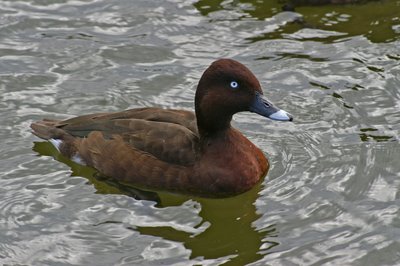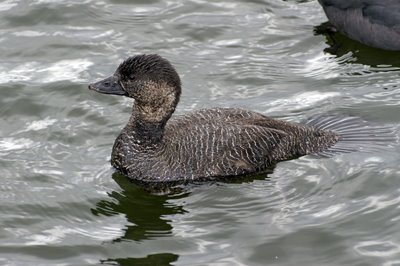Today I was taken out for a real treat by Tun Pin Ong, a keen Malaysian birder temporarily residing in Sydney. It was so good to be able to go out with someone who knew the ropes, and I really benefitted from his local knowledge.
First stop was Centennial Park where Tawny Frogmouths are resident. Tawny Frogmouths are not uncommon in Sydney, but their cryptic camouflage makes them easy to overlook, as I had done on all my previous trips. On arrival at the lake I saw my first new bird of the trip - Hardhead, a diving duck which is common enough in the right habitat - I just hadn't visited any right habitat until now! They are reminiscent of Ferruginous Duck, which we see in the UK as an occasional visitor.
 A male Hardhead.
A male Hardhead. Among the melee of Hardheads, Coots, Black Swans and pelicans that were coming to be fed we also spotted a lone female Musk Duck, which looks like a cross between a scoter and a Ruddy Duck! We were intrigued to count how many tail feathers she had. Most bird species have 12, but she seemed to have about 20!
Among the melee of Hardheads, Coots, Black Swans and pelicans that were coming to be fed we also spotted a lone female Musk Duck, which looks like a cross between a scoter and a Ruddy Duck! We were intrigued to count how many tail feathers she had. Most bird species have 12, but she seemed to have about 20! Tun Pin told me that the best chance we had of finding the frogmouths was to hope a local would point them out. This is exactly what transpired. A friendly man, of Mediterranean origin I would guess, made his way over to us and went out of his way to point out not only the frogmouths - the female sitting on her nest with one large fledgling and a male roosting in a tree nearby - but also a possum hiding in its daytime bed. The man had no binoculars but was obviously equipped with hawk-like eyes!
 The female frogmouth on her nest.
The female frogmouth on her nest.
The male succeeding in looking inconspicuous in a nearby tree.Leaving Centennial Park behind, we headed for Tun Pin's 'local patch' - a sandspit at the mouth of the Penrhyn River. Having seen some of his pictures from here online, I was really looking forward to visiting the place 'in the flesh'.
One of the brilliant things about birding is that you get to visit some really unlikely places! So it was that we veered past the airport, down a dirt track near a container port, and ended up at a dead-end where, on a launch-ramp into the river, the local fire crew were testing out their fire-hoses! I wondered how many other tourists had ever set foot on this particular spot. Just beyond the fire engine was a small sandspit with a small roost of gulls, terns and waders, with the blue waters of the bay beyond them. We hadn't brought a telescope with us, and I was wondering how we were going to get anywhere near close enough to identify them, but I needn't have worried - Tun Pin had a cunning plan - just walk right up to them!
Huh! To get a decent picture of a wader in Malaysia I have to spend 3 hours in a cramped hide in 100% humidity and 34 degrees sweltering heat; here, in nice cool wind and bright yet not hot sunshine, you can just walk up to the birds, and take as many pics as you like in perfect light. Something's not right somewhere!
 Here's a nice illustration of the difference in size and bill length between male (front) and female (behind) Bar-tailed Godwits. I think the male bird is a juvenile, with the bright notched and edged scapulars and coverts, while the female is an adult, as can be seen from her plainer grey-brown non-breeding feathers, with the odd old black and white breeding plumage scapular still hanging on.
Here's a nice illustration of the difference in size and bill length between male (front) and female (behind) Bar-tailed Godwits. I think the male bird is a juvenile, with the bright notched and edged scapulars and coverts, while the female is an adult, as can be seen from her plainer grey-brown non-breeding feathers, with the odd old black and white breeding plumage scapular still hanging on.One of the fascinating things for me about seeing these Bar-tails is that they are a different race from the ones I have been seeing in Malaysia. These are the race
baueri, and they have the distinction of making the longest known non-stop migratory flight of any bird - around 11,000km - from Alaska to the east coast of Australia and New Zealand. Before making the trip, the birds feed up, adding up to 50% of their body weight in fat. Once they take off, it may be a week or more before they touch land again! To read more about this incredible feat, click
hereBaueri race Bar-tails are distinct from the race that passes through Malaysia in that they have a brown rather than white back, and more heavily barred uppertail, rump, underwing and axillaries. They are also bigger.
 After a non-stop flight of up to 11,000km, I reckon these birds deserve a rest!
After a non-stop flight of up to 11,000km, I reckon these birds deserve a rest!
I tried to get a shot of the rump and back, but this was the nearest I got!In addition to the above differences, I thought that the juveniles looked buffier, almost tawny, compared to the
menzbieri race which we see in Malaysia, on their way to the wintering grounds in North-west Austrlia. In addition, the juveniles seemed to have a distinctive orangey-buff colouration to the supercilium in front of the eye.
 A couple of juvenile Bar-tails.
A couple of juvenile Bar-tails.Apart from the Bar-tailed Godwits the only other waders visible on the spit were a few Red-necked Stints and a couple of Curlew Sandpipers. One of the stints was wearing leg-flags - orange above green on the right tibia, which indicates that the bird was probably ringed at that very spot, since my leg flag chart, kindly supplied by the
Australasian Wader Studies Group, says 'Orange/Green - NSW, Australia, Stockton, Penrhyn Inlet'.
 The leg-flagged stint to the right of an uncharacteristically large individual with an odd white half-collar.
The leg-flagged stint to the right of an uncharacteristically large individual with an odd white half-collar.The gull and tern roost was predominantly Silver Gulls and Crested Terns.
 Crested Terns are offshore visitors to Malaysia, so it's really great to be able to view them up close and personal!
Crested Terns are offshore visitors to Malaysia, so it's really great to be able to view them up close and personal!However, there was one gull and one tern that were different - a Kelp Gull - which looks halfway between a Lesser and Greater Black-backed Gull that I'm familiar with from UK, and a White-fronted Tern. The latter was my third 'lifer' of the day, and one that I was particularly pleased to see. They are uncommon winter visitors from New Zealand and are usually gone by early October, so I guess I was a little fortunate!
 Kelp Gull - clearly a subadult. I'm not sure where this species has a 3 or 4 year maturity period. At any rate, I reckon it's one full moult away from adult-type plumage - so either 2nd or 3rd winter.
Kelp Gull - clearly a subadult. I'm not sure where this species has a 3 or 4 year maturity period. At any rate, I reckon it's one full moult away from adult-type plumage - so either 2nd or 3rd winter. This White-fronted Tern looks like a 1st winter bird, with fresh scapulars and median coverts but very worn lesser and greater coverts. This bird had a distinctive rectangular headshape. It can also be identified by the white trailing edge to the inner primaries.
This White-fronted Tern looks like a 1st winter bird, with fresh scapulars and median coverts but very worn lesser and greater coverts. This bird had a distinctive rectangular headshape. It can also be identified by the white trailing edge to the inner primaries.


























































